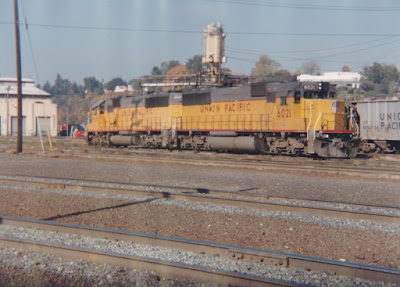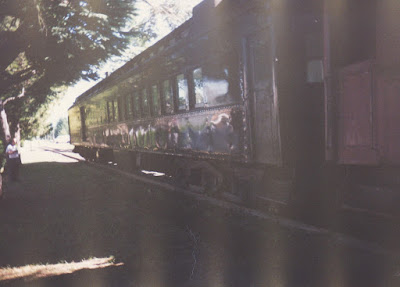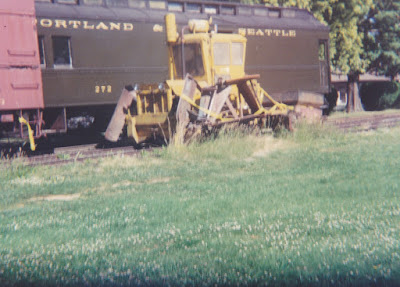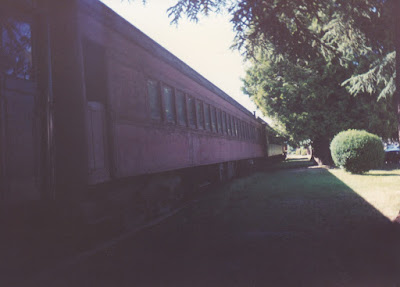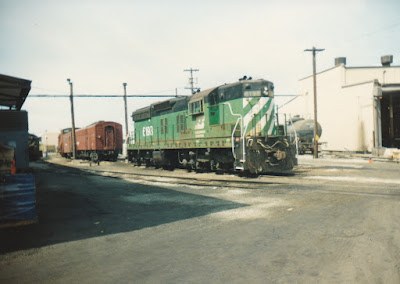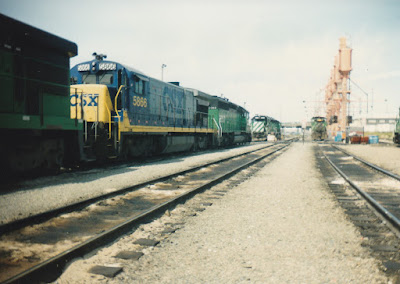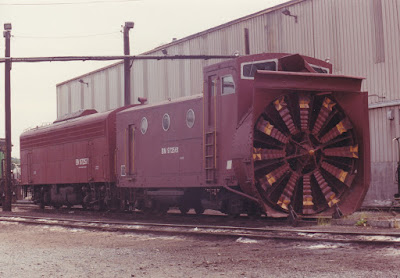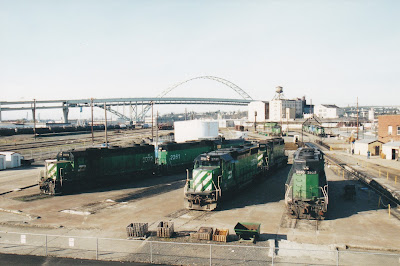These pictures were taken while railfanning in Portland, Oregon, in the fall of 1994. Most were taken at Union Pacific's Albina Yard, where we begin with a pair of locomotives moving through the yard.
Union Pacific #5030 is a 3,600-horsepower SD50 that was built by the Electro-Motive Division of General Motors in December 1984. It was originally delivered in Union Pacific colors but with Missouri Pacific lettering. It was relettered for Union Pacific in July 1990.
Union Pacific #6021 is a 3,800-horsepower SD60 that was built by the Electro-Motive Division of General Motors in April 1986.
This pair of locomotives disappeared into the engine terminal, and my attention turned to some of the other sights.
Union Pacific 906 & 907 are 3,000-horsepower GP40-2s that were originally built by the Electro-Motive Division of General Motors in April 1980 as Western Pacific #3551 & #3552. The Western Pacific was merged into the Union Pacific in 1983. Western Pacific #3551 was renumbered to Union Pacific #906 in January 1984. Western Pacific #3552 was repainted in Union Pacific colors with Missouri Pacific lettering in July 1985 as Missouri Pacific #907. It was relettered for Union Pacific in June 1988, but in this picture its Missouri Pacific lettering is showing through its Armour Yellow paint.
Stored in the back of the engine terminal were two old Baldwin locomotives. The red and yellow locomotive is Oregon & Northwestern #2, a 1,600-horsepower AS-616 that was built by the Baldwin Locomotive Works in September 1950 as Southern Pacific #5239. It was sold to the Oregon & Northwestern in 1964. The Oregon & Northwestern shut down in March 1984 and the locomotive was stored until the line was abandoned in 1990 and it was sold to the Pacific Northwest Chapter of the National Railway Historical Society.
The white locomotive is a 1,200-horsepower S-12 that was built by Baldwin-Lima-Hamilton in November 1952 as Southern Pacific #1498. In March 1956 it was transferred to Southern Pacific's subsidiary Texas & New Orleans and renumbered to T&NO #121. In 1965, it was renumbered again to Southern Pacific #2124. It was retired in July 1970, traded in to General Electric, and delivered to dealer Chrome Crankshaft in Vernon, California. In February 1972, it was sold to Ketchikan Pulp & Paper Company in Ward's Cove, Alaska, where it became #5321. It was donated to the Pacific Northwest Chapter of the National Railway Historical Society in March 1991.
Union Pacific #9057 is a 3,600-horsepower C36-7 that was built by General Electric in November 1985. It was originally delivered in Union Pacific colors but with Missouri Pacific lettering. It was relettered for Union Pacific in 1988.
Union Pacific #2025 is a 2,000-horsepower GP38-2 that was built by the Electro-Motive Division of General Motors in May 1974. Also pictured here are two Union Pacific switchers. I can't make out their numbers, but the closer one is an EMD MP15DC, and the other one is an SW10 that was rebuilt by Union Pacific's Omaha Shops from an earlier EMD switcher.
Union Pacific #1312 is a 1,500-horsepower MP15DC that was originally built by the Electro-Motive Division of General Motors in May 1975 as Pittsburgh & Lake Erie #1588. It was purchased by Union Pacific in December 1984 and delivered in April 1985. It was initially assigned Union Pacific #1012, and was renumbered in September 1987 to Union Pacific #1312. Also sneaking into the frame is some visiting motive power from the Burlington Northern.
Burlington Northern #3053 is a 3,000-horsepower GP40-2 that was originally built by the Electro-Motive Division of General Motors in May 1979 as St. Louis-San Francisco (SLSF, also known as the Frisco) #763. The Frisco was merged into the Burlington Northern in 1980, and this locomotive was renumbered to Burlington Northern #3053.
Burlington Northern #2265 is a 2,000-horsepower GP38-2 that was built by the Electro-Motive Division of General Motors in July 1973 as St. Louis-San Francisco (SLSF, also known as the Frisco) #410. The Frisco was merged into the Burlington Northern in 1980, and this locomotive was renumbered to Burlington Northern #2265.
Across the river, and possibly on another day, this private passenger car was on the end of an Amtrak passenger train leaving Portland's Union Station. I didn't get a good enough picture out the car window to be able to identify it, though it appears to have been built by Budd, but seeing as how I was looking into the late afternoon sun, it is amazing that it came out as well as it did.



